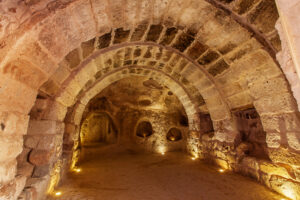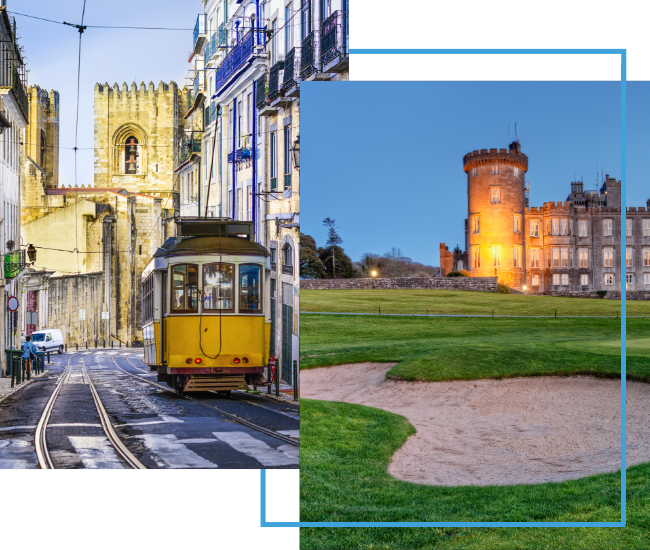Every city has hidden depths. Beneath the streets lie extensive networks for essential utilities. Many cities also construct subterranean networks for transport, storage, shopping, refuge, burial and even housing. These underground worlds may originally be natural or entirely manmade. They may be open to all or off-limits. And most people remain oblivious of their existence.
That’s true of Vienna, where the majority of visitors don’t notice the petal-like metal cover embedded into cobbles in Girardi Park, a sliver of open space amid a busy intersection. If you’ve seen the classic 1949 film The Third Man, in which Orson Welles plays a man running for his life, you know the metal cover provides a portal to an underground labyrinth. On The Third Man Tour — at 3 p.m. Thursdays through Sundays from May to October — your guide will peel open the metal cover to reveal spiral steps. Down you go, into the sewer.
The movie culminates with a memorable chase sequence filmed within this small section of Vienna’s 1,550-mile-long sewer system. Down here, within sturdy arched tunnels, the city feels distant. Does it stink? Not as badly as you’d imagine, and if you visit on the weekend, when many locals do their washing, soap suds mask the worst of the stench.
In Paris, just a couple of blocks from the Eiffel Tower, explore an entire museum dedicated to the sewer system. Musée des égouts de Paris encompasses a third of a mile of tunnels. There’s a dry section, with permanent displays about the history and operations of the system, and a wet section, in which visitors get to walk along walkways above the flowing sewers. (The wet section closes when the water level is too high.)

© BUKKI88 | DREAMSTIME
To the south, under the Parisian district of Montparnasse, lies one of the world’s creepiest subterranean landmarks, the Catacombs of Paris. The stone that built the city was excavated from this area, leaving behind a huge warren of manmade caves five stories beneath the surface. In the 18th century these caves became ossuaries for the dead, and in time the remains of more than 6 million people were interred here.
The catacombs have since become an unlikely tourist attraction and are so popular, you’re advised to book a time slot for your visit at least a week in advance. Visitors descend 131 steps and enter the tunnels under an engraved sign proclaiming, “Arrête! C’est ici l’empire de la mort.” (“Stop! This is the empire of the dead.”) Sure enough, the dead lie everywhere: Bones and skulls are stacked into the walls of the corridors and chambers of the 1-mile route. This eerie netherworld is cold and humid and certainly not for the faint-hearted. But few places immerse you in history quite like the catacombs. They have shaped Paris not just below ground but also on the surface. The buildings immediately above are predominantly low- rise because the hollow ground won’t support tall buildings.
Rome is another European city with an extensive historical underworld. The city’s bedrock is riven with tunnels and crypts, many dating back more than 2,000 years. The Domitilla Catacombs cover an area of more than 10 miles, hold the remains of 150,000 people and even feature an ancient underground Christian basilica. The Catacombs of Callixtus include the Crypt of the Popes; so many popes have been interred here, the catacombs are nicknamed “Little Vatican.”
Subterranean worlds are often shrouded in mystery. In Rome it is often claimed the catacombs were created by Christians forbidden from worshipping or burying their dead within the city walls, and so they went underground. Many historians dispute this and insist the main reason for going underground was the high price of land on the surface.
Even recent history is subject to debate. Beneath Portland, Oregon, a complex of linked passages and basements has collectively become known as the Shanghai Tunnels. Visitors can see a small section on group tours. According to legend, these tunnels were used for smuggling goods and to kidnap — or “shanghai” — able men for service on ships in the nearby port. The truth is probably less dramatic: They merely provided a means of delivering goods without being obstructed by traffic and people in the streets.
Similarly, in Moose Jaw, Canada, there have long been stories of tunnels which provided refuge for Chinese immigrants and were subsequently used by Al Capone to store liquor during Prohibition and then as a 1950s Cold War bunker. The Tunnels of Moose Jaw is a popular visitor attraction offering interactive, theatrical tours bringing this underworld history to life. The reality is contested, and most historians claim the existence of an extensive tunnel network under Moose Jaw is an urban myth. Still, the tours are fun and provide an immersive experience of three eras of North American history.

PHOTO:
© IGOR STRAMYK
| DREAMSTIME
The existence of underground cities in Türkiye is beyond doubt, though mysteries remain as to exactly when they were built and who built them. Until recently, the largest was thought to be Derinkuyu in Cappadocia, which may have been excavated by the Phrygians more than 3,000 years ago. Carved into volcanic rock, with connected tunnels and chambers extending to 18 levels, it was inhabited for centuries, supporting up to 20,000 residents. Intriguingly, recent research suggests the existence of up to 200 underground cities in the region, all interconnected. It’s thought their main purpose was to protect the population from foreign invaders.
In modern cities there are other reasons to take shelter. The weather, for instance. In Toronto the severe winters are mitigated by PATH, a network of tunnels extending 19 miles, connecting 70 buildings, and housing more than 1,200 shops. It is acknowledged as the world’s largest underground shopping complex.
Similar underground malls provide refuge from heat or cold, or traffic and pollution in the United States (including Houston, Oklahoma City and Philadelphia); South Korea (central Seoul); Japan (especially Fukuoka and Tokyo); and China (numerous cities). In Kansas City a 1,100-acre former limestone mine has been transformed into SubTropolis, a huge underground system of tunnels and storerooms used for logistics and storage.
Not all of these networks have thrived. In Texas the Dallas Pedestrian Network, conceived in 1969, was once a comprehensive system of tunnels and shops under downtown. Section closures and private owners blocking access reduced its viability, and now most people at street level — visitors and locals alike — are unaware of its existence.

© MEHMET CETIN | DREAMSTIME
How easy it is for a society to forget its heritage. In 2020 in the Turkish town of Midyat on the border with Syria — hundreds of miles from the well-known sites in Cappadocia — workers on a construction project broke through into an ancient tunnel. It soon became apparent they had discovered a lost underground city, Matiate. Only about 3 percent of the city has been excavated so far, but early estimates suggest it was inhabited for 2,000 years and was home to 70,000 people, making it the largest underground city ever discovered, complete with underground churches and a synagogue. When it comes to discovering our subterranean history, we’ve barely scratched the surface.
Read This Next

Introducing
FX Excursions
FX Excursions offers the chance for once-in-a-lifetime experiences in destinations around the world.
#globility
Insta FeedApril 2025
Apr 6, 2025A World of Wellness
According to Merriam-Webster, wellness, a noun, is defined as “the quality or state of being in good health especially as an actively sought goal.” As the definition states and as the travel industry knows, wellness reaches far beyond just simply being not sick; for some, the idea of wellness is an entire lifestyle. Wellness is sought daily, at home and, for many, while traveling. The meaning of the word can also shape-shift depending on the person. Maybe for you it’s morning meditation every day, while for your neighbor it’s splurging on a luxury spa day while on a beach vacation.
Sponsored Content
A Summer Sojourn Along Europe’s Rivers with AmaWaterways
This summer, elevate your vacation experience with award-winning AmaWaterways. Offering a seamless blend of unparalleled luxury, authentic cultural experiences and unrivaled service, AmaWaterways cruises are the perfect way to uncover the heart of Europe during the sunniest season with itineraries that glide along the continent’s most iconic rivers, including the Danube, the Rhine, the Seine and the Douro.
April 2025
Apr 6, 2025Good to Go
As usual, we have a lot going on at Global Traveler. We are about to start our efforts with the Children’s Crisis Treatment Center Roundup Gala, to be held Oct. 24 in Philadelphia. The organization asked me to serve as cochair with John Kelley, a member of the Advisory Board of FXExpress Publications, Inc. Last year’s event surpassed that of 2023, so we have big shoes to fill for 2025.
Daily
Apr 4, 2025Which European Cities Have the Best, Worst Metro Networks?
International luggage storage company Bounce researched Europe’s metro services across the continent’s capital cities and made some interesting discoveries.
Sponsored Content
Madrid: The Charm of an Authentic City
They say Madrid is in vogue for many reasons: its lifestyle, its heritage, its cuisine and all of its new attractions. And it’s true, because Madrid is on the radar of travelers looking for a cutting-edge destination that still holds onto its essence. Join us as we explore its charms.
April 2025
Apr 4, 2025Focus on Mental, Physical and Emotional Health at U.S. Wellness Destinations
Wellness has been a buzzword in the travel space for a handful of years now, and it is here to stay. “Wellness travel is no longer a trend; it’s a transformative shift in how people approach travel as a whole,” said Robin Ruiz, founder and CEO, Wellness in Travel + Tourism. “In today’s fast-paced world, our lives are increasingly full and often overwhelming, which is why travelers are turning to wellness-focused trips that prioritize well-being. People no longer just want a break from their daily routine — they want experiences that nourish their mental, physical and emotional wellbeing.”
Spring Hotel Openings from IHG Hotels & Resorts
Daily
Apr 4, 2025Greek Hotel Brand Goes Big for Easter
Daily
Apr 3, 2025Spa All Day at The Ritz-Carlton, Bachelor Gulch
Daily
Apr 3, 2025What’s New in Luxury Travel in Rome
Daily
Apr 2, 2025Daily
Apr 2, 2025Sonoma Wine Country Hotel Unveils Exclusive Spring Experiences
Hotel Healdsburg recently announced a lineup of new spring experiences to immerse guests in the beauty of Sonoma Wine Country.
Sponsored Content
Royal Air Maroc Marks Five Years with oneworld: Strengthening Connectivity Between USA and Africa and Expanding Global Reach
Royal Air Maroc proudly enters its fifth year as a member of the prestigious oneworld alliance. Since joining in April 2020, RAM has demonstrated resilience during the COVID-19 pandemic, emerging as a dynamic airline that enhanced its digital services and expanded its network. The airline plans to grow its fleet to 200 aircraft by 2037, reinforcing its global presence.
eFlyer Reviews
Apr 2, 2025Wyndham Sun Moon Lake Review
Sun Moon Lake has long been the go-to place for Taiwanese families and friend groups to escape Taipei, Kaohsiung and other bustling cities with its fresh air, thick forests, clear water, misty sunrises and alpine views. Wyndham Sun Moon Lake, opened November 2024, provides international visitors with an even greater incentive to rent a car or take high-speed rail (TaiChung HRS) to explore this “best-kept secret” area.
ShareThis